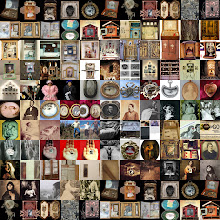Joseph Cornell (1903-1973) fue un artista norteamericano, uno de los pioneros y más famoso exponente del arte de los assemblage. No recibió enseñanza artística, fue autodidacta, y su obra más característica son sus 'cajas.' Son cajas de madera sencillas, con un cristal, y dentro pone fotografias, objetos y texto. Se dice que combina la austeridad formal del constructivismo y la fantasía del surrealismo. Emplea objetos no de desecho, como Kurt Schwitters, si no fragmentos de cosas preciosas y valiosas combinándolos para evocar nostalgia.
De arriba abajo y de izquierda a derecha: Object (Roses des Vents) 1942-53, Aviary Parrot Box with Wire Drawers 1949, Untitled (Apollinaris) 1954, L'Egypte de Mlle Cleo de Merode, cours élémentaire d'histoire naturelle 1940, Cassiopeia 1 1960, Untitled (Soap Bubble Set) 1936, Tilly Losch 1935, Untitled (Medici Princess) 1948, Untitled (Medici Boy) 1942-52, Untitled (Bebe Marie) 1940.
"By collecting and carefully juxtaposing found objects in small, glass-front boxes, Cornell created visual poems in which surface, form, texture, and light play together. Using things we can see, Cornell made boxes about things we cannot see: ideas, memories, fantasies, and dreams. (...) In Homage to the Romantic Ballet, plastic ice cubes become jewels when set in a velvet-lined box, souvenirs of a famous ballerina's midnight performance on the frozen Russian steppel. (...) A symbolist, Cornell used the found materials that inhabit his boxes—paper birds, clay pipes, clock springs, balls, and rings—to hint at abstract ideas. (...) Although his constructions are enveloped in nostalgia—the longing for something that happened long ago and far away—their appearance is thoroughly modern." (http://www.josephcornellbox.com/boxes.htm)
"By collecting and carefully juxtaposing found objects in small, glass-front boxes, Cornell created visual poems in which surface, form, texture, and light play together. Using things we can see, Cornell made boxes about things we cannot see: ideas, memories, fantasies, and dreams. (...) In Homage to the Romantic Ballet, plastic ice cubes become jewels when set in a velvet-lined box, souvenirs of a famous ballerina's midnight performance on the frozen Russian steppel. (...) A symbolist, Cornell used the found materials that inhabit his boxes—paper birds, clay pipes, clock springs, balls, and rings—to hint at abstract ideas. (...) Although his constructions are enveloped in nostalgia—the longing for something that happened long ago and far away—their appearance is thoroughly modern." (http://www.josephcornellbox.com/boxes.htm)

Homage to the Romantic Ballet, 1942













